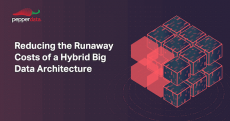Reducing the Runaway Costs of a Hybrid Big Data Architecture

According to Gartner, as of 2019, 35% of CIOs are decreasing their investment in their infrastructure and data center, while 33% of them are increasing their investments in cloud services or solutions.
Today, almost every large enterprise has carried out some migration to the cloud for their big data/Hadoop workloads. This movement to the cloud was only accelerated in part due to the Coronavirus pandemic of 2020. But when enterprise IT organizations receive their first few cloud bills, many are shocked by the large costs they’ve incurred. IT operations teams are in a visibility crisis, which then becomes a cost crisis. What makes matters worse, is that many IT Operations teams struggle to navigate the crisis, or understand why there even is such a crisis to begin with.
We’ve found that as the infrastructure migrates to the cloud, the trouble starts when CapEx costs are exchanged for OpEx costs. While budgets were simple and clear-cut in the data center using a CapEx model, spend can get complex and hard to define within a cloud-based OpEx model without proper visibility. Costs get even trickier to control in the cloud due to a lack of a hard-coded capacity ceiling. In short, an OpEx model combined with the infinite resources the cloud allows is a recipe for almost guaranteed overspending. So how can your organization avoid this?
Download the white paper Reducing the Runaway Costs of a Hybrid Big Data Architecture to learn how you can gain control of your runaway hybrid big data costs. You’ll get the details surrounding why a lack of visibility equals higher costs, how you can transition from a CapEx to OpEx model without falling victim to surprisingly high cloud bills, how Pepperdata can help, and more. Just fill out the form to the right to take the first step towards controlling your hybrid big data architecture costs today.

